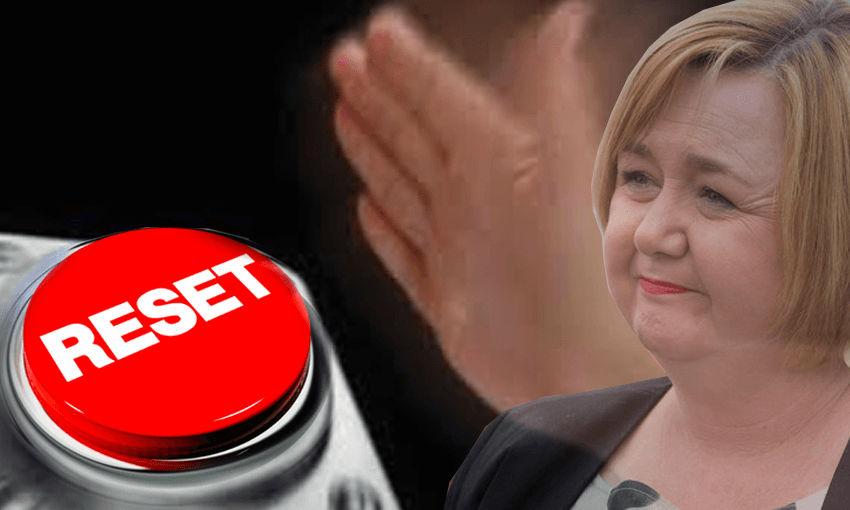Almost two years on, the coalition government’s flagship KiwiBuild programme has been given a ‘reset’, with the big 100,000 target – and all the targets along the way – thrown in the bin.
What just happened?
Megan Woods has pressed a reset button, detonating a controlled explosion beneath the government’s big KiwiBuild housing programme. The housing minister was frank: “KiwiBuild isn’t working so we are changing it.”
What does this reset entail?
The overarching target of the programme – 100,000 new houses to be built over 10 years – has been chucked in the skip. “It was overly ambitious,” Woods acknowledged. Targets were “driving perverse outcomes” and “led to contracts being signed in places where there was little first home buyer demand.” It will be replaced by one of the most beloved metaphors of modern politics: a “dashboard”, which will measure monthly the progress of KiwiBuild.
Wait, is that the same 100,000 target that Winston Peters described in May as ‘easily achievable’?
The very same.
What else?
Nothing seismic, to be honest. Announcing the reset, Woods said “there is no silver bullet”.
There is a move to provide “new innovative ways of buying a home”. That includes enhancing $400 million targeted at “progressive ownership” options, such as rent-to-buy and shared-ownership schemes.
The government will reduce from 10% to 5% the “first home grant” deposit required for a government-backed mortgage, and adjust the amount paid to developers to disincentivise falling back on the government underwrite, rather than selling through the KiwiBuild scheme.
Buyers of studio and one-bedroom homes will no longer have to commit to living in the home for three years; one year will suffice.
The KiwiBuild homes that have failed to sell will be released on the open market.
Kainga Ora, the urban development agency, will be tasked with an increased focus on targeting the parts of the country best suited to KiwiBuild developments, and addressing the mix of requirements for public, KiwiBuild and commercial housing. And they’ll be looking for “opportunities for build to rent with long-term institutional investors”.
What is ‘build to rent’?
An approach to housing that has become increasingly popular overseas, build-to-rent involves the construction of dwellings expressly for the purpose of rental accommodation, but guaranteeing longer-term, secure tenancies, with commercial and institutional investors attracted by the opportunity to build apartments on Crown land. Some commentators had looked to the government to go further than “looking for opportunities”, and to power up state and social house building programmes.
Where did KiwiBuild all begin?
On a grey Sunday afternoon at the Ellerslie Event Centre, Labour leader David Shearer addressed his party conference. “It’s time for the government to step up and we will,” he said. “Today, I am announcing we will put 100,000 Kiwi families into their first home.” That brought a 30-second standing ovation, and David Shearer grinned, looking suddenly lighter, as if a David-Cunliffe-shaped burden had floated suddenly away.
With the dream of house ownership becoming utterly out of reach for thousands of New Zealanders, KiwiBuild – reportedly the brainchild of Annette King – would see the government use its scale and buying power to deliver 100,000 “affordable starter homes”, a reachable rung on the ladder. It would also boost supply, helping to cool an overheated property market.
All it took was five years, three leadership changes, and two elections and Labour’s flagship house building policy was made real.
How did that go?
Not well. The target was 100,000 houses in a decade, with 1,000 homes in the first year, 5,000 in the second, 10,000 in the third, then 12,000 a year thereafter. It didn’t turn out like that.
As we approach the two year mark, how many have been built?
Not so many.
How many?
258.
Any other issues?
A few. There were snafus over the structure of the unit overseeing the project, complaints from developers, an over-reliance on “buying off the plans”, escalating costs for some of the houses, a failure even to find willing buyers for some of them, the general, thudding realities of New Zealand’s construction economy and regulatory web, and the controversy-surrounded resignation of the head of the KiwiBuild unit. National housing spokesperson Judith Collins enjoyed field day after field day. Ten weeks ago, amid talk of recalibrations and resets, Phil Twyford got himself reshuffled out of town, losing the housing portfolio, which was split into three, with Megan Woods at the KiwiBuild helm.
Would that be the same Megan Woods who wrote the PhD thesis ‘Integrating the nation: Gendering Māori urbanisation and integration, 1942-1969’?
Yes. Have a biscuit.
How did today’s announcements go down?
The community housing providers in the KiwiBuy coalition liked it. The group, which includes Salvation Army, Habitat for Humanity, Housing Foundation and Community Housing Aotearoa, issued a release headed “Door to home ownership has been opened”, saying, “Today’s announcement by Government of its intention to work with the community housing sector and others in the development of a $400m progressive home ownership package is warmly welcomed.”
And the opposition?
Judith Collins reckoned it amounted to “scrapping KiwiBuild in all but name”. She said, “The long-awaited KiwiBuild reset has proven to be a damp squib, with all the elements that made the policy unique now consigned to the rubbish bin.” And: “It’s pretty easy to achieve targets when there aren’t any, which appears to be the government’s strategy on housing… New Zealanders who dream of home ownership will feel justifiably let down by the KiwiBuild reset. The three key elements are gone – there’s no 100,000 homes target, price caps have been loosened and the asset test for ‘second chancers’ is no more.”

